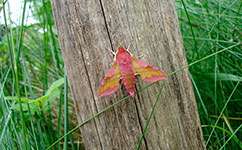Changes in farming and climate hurting British moths

Britain's moths are feeling the pinch – threatened on one side by climate change and on the other by habitat loss and harmful farming methods. A new study gives the most comprehensive picture yet of trends in moth populations, showing that these pressures put them in a similar position to other, better-studied UK animal groups.
Generally nocturnal and often a touch frumpy, moths don't have the glamour of other pollinating insects like butterflies and bees; they get limited media attention and rarely attract celebrity-fronted conservation initiatives. But they are just as important in many UK ecosystems; they carry out valuable pollinating work on plants, including crops, and provide food for many birds and other predators.
Dr Tom Oliver of NERC's Centre for Ecology & Hydrology (CEH), one of the paper's authors, suggests we need to protect existing wild habitats and if possible create new ones. This would help many organisms keep pace with changing conditions – not just moths.
'The British countryside has been severely degraded by decades of agricultural intensification,' he says. 'So moths are in a poor position in terms of coping with climate change. To give them a fighting chance, we need to make sure they have the habitats they need to flourish.' That might involve anything from planting wildflowers and safeguarding roadside verges to creating new nature reserves.
Researchers from CEH and Butterfly Conservation examined a long-term dataset containing records of some 90 million moth sightings between 1970 and 2010, and used the results to assess changes in populations of 673 different British species. This is the biggest survey of moth abundance ever carried out, taking in data on moth sightings from almost every part of Britain.
Their conclusions weren't comforting, Oliver explains; many more moths have declined significantly – 260 species – than have made comparable gains – just 160. Overall, sightings became rarer, mirroring trends in butterflies and other groups that have been more intensively studied than moths. The authors suggest the same factors are probably to blame. One is climate change, which is making life hard for moths that are adapted to colder UK climates, driving some species out of southern England.
The other is the transformation of the UK countryside, with far more land now under intensive cultivation and regularly exposed to modern farming practices like ploughing, fertilizers and pesticides. These slash the number of plant and animal species found in a given area of land; in particular high levels of nitrogen pollution from fertiliser use tend to lead to a few well-adapted species outcompeting everything else.
'The overall picture is similar to what we've found in other groups like butterflies, beetles or birds,' says Oliver. 'Climate change is having an effect, and you would expect that to favour species that thrive in warmer conditions at the expense of cold-loving species. We did see some of that, but even many warmth-loving moths are in decline; we think that's because of the effects of habitat loss and modern farming methods on top of the changes in climate.'
Often, he explains, while a species could theoretically move across the countryside to keep within the climate it thrives in, it can be blocked by an absence of suitable habitats to act as stepping stones. So the advance of intensive farming adds to the difficulty of adapting to a warmer Britain.
Widespread moths, predicted to be at more risk from changes in land use than from climate change, declined sharply, especially in the southern UK; this supports the idea that farming practices are at present the bigger problem. Moths associated with low nitrogen and open environments – that is, ones that depend on plants which are increasingly threatened by intensive farming techniques – saw the worst declines. Some moths that reach the northern edge of their range in southern Britain increased in number, but others that are currently restricted to the north declined. That said, the picture is complex and these general rules didn't apply to all the moths examined.
Even if a particular moth prefers warmer conditions, climate change may prove a mixed blessing. It's expected to make the weather more variable, with more intense rainfall, harsh winters and drought, and this could make life even harder for many moth species.
For reasons we don't fully understand, there are many more species of moth in the UK than of other related insects. There are more than a thousand UK species of large moth, but only about 50 butterflies. This meant the scientists could test their ideas against a larger dataset for moths than they could in less diverse families. Oliver says the UK's greater number of moths compared with butterflies may partly be to do with the latter group's preference for warm climates, meaning Britain is for many at the far edge of the temperature range they can tolerate.
The moth data the scientists were drawing on was collected by dedicated volunteers – moth enthusiasts who put out light traps at night and later return to identify the species they've caught.
The study appears in the Journal of Applied Ecology.
More information: "Long-term changes to the frequency of occurrence of British moths are consistent with opposing and synergistic effects of climate and land-use changes." Richard Fox, Tom H. Oliver, Colin Harrower, Mark S. Parsons, Chris D. Thomas and David B. Roy. Journal of Applied Ecology, Volume 51, Issue 4, pages 949-957, August 2014. DOI: 10.1111/1365-2664.12256.
Journal information: Journal of Applied Ecology
Provided by PlanetEarth Online
This story is republished courtesy of Planet Earth online, a free, companion website to the award-winning magazine Planet Earth published and funded by the Natural Environment Research Council (NERC).



















